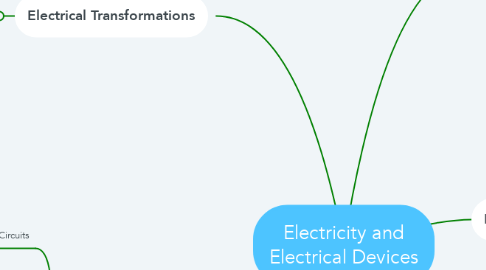
1. Static Electricity
1.1. Static Electricity in our Everyday Lives
1.1.1. Walking on a Carpet
1.1.2. Putting on a Sweater
1.1.3. Combing your Hair
1.1.4. Clothes sticking together when they come out of the dryer
1.2. How do we make static electricity?
1.2.1. Protons
1.2.2. Electrons
1.2.3. Neutrons
2. Environmental Impacts
2.1. Energy Sources
2.1.1. Wind
2.1.2. Solar
2.1.3. Nuclear
2.1.4. Hydro
2.1.5. Thermal
2.2. Community Impacts
2.2.1. At Home
2.2.2. At School
2.2.3. Changing with Time
3. Electrical Transformations
3.1. Energy Transformations
3.1.1. Heat
3.1.2. Sound
3.1.3. Light
3.1.4. Mechanical
3.2. Energy Transformations in our Lives
3.2.1. Environmental Impacts
3.2.2. What electrical energy do we use everyday?
3.2.3. How can we reduce our energy consumption?
3.2.4. Community impacts
4. Electrical Circuits
4.1. Types of Circuits
4.1.1. Simple Circuits
4.1.2. Series Circuits
4.1.3. Parallel Circuits
4.1.4. Open Circuits
4.1.5. Closed Circuits
4.2. Components in a Circuit
4.2.1. Source of Voltage
4.2.2. Conductive Path
4.2.3. Resistors
4.3. Conductors and insulators
4.3.1. Conductors of Electricity
4.3.2. Insulators of Electricity
4.3.3. Properties of Conductors
4.3.4. Properties of Insulators
4.3.5. Roles of conductors and insulators in circuits
4.3.6. Atoms
5. Renewable and Non Renewable Energy
5.1. Renewable Resources
5.1.1. sources that are continuously replenished in a reasonable time
5.1.1.1. Solar
5.1.1.2. Wind
5.1.1.3. Hydro
5.1.1.4. Biomass
5.1.1.5. Geothermal
5.2. Non Renewable Resources
5.2.1. sources that are used and cannot be replenished in a short period of time
5.2.1.1. Coal
5.2.1.2. Oil
5.2.1.3. Natural Gas
5.2.1.4. Nuclear Energy
